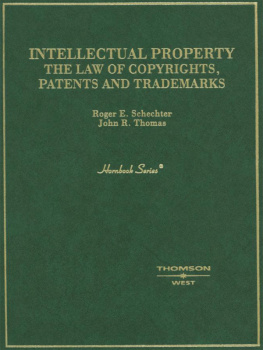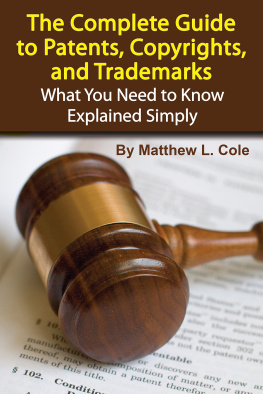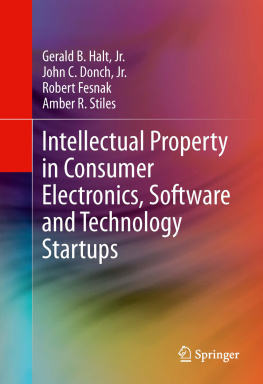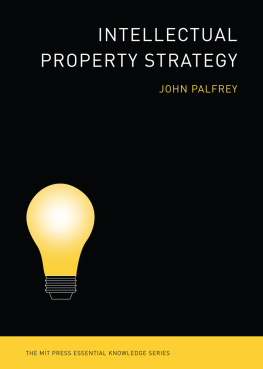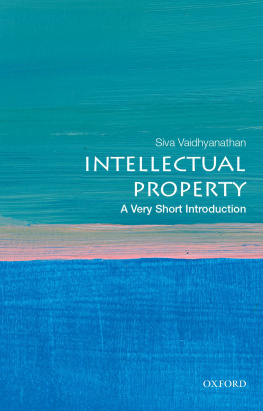Landmarks
Page list

WESTS LAW SCHOOL
ADVISORY BOARD
_________
JESSE H. CHOPER
Professor of Law,
University of California, Berkeley
DAVID P. CURRIE
Professor of Law, University of Chicago
YALE KAMISAR
Professor of Law, University of Michigan
Professor of Law, University of San Diego
MARY KAY KANE
Chancellor, Dean and Distinguished Professor of Law,
University of California,
Hastings College of the Law
WAYNE R. LaFAVE
Professor of Law, University of Illinois
ARTHUR R. MILLER
Professor of Law, Harvard University
GRANT S. NELSON
Professor of Law, University of California, Los Angeles
JAMES J. WHITE
Professor of Law, University of Michigan
i
INTELLECTUAL PROPERTY THE LAW OF COPYRIGHTS, PATENTS AND TRADEMARKS
By
Roger E. Schechter
Professor of Law,
George Washington University
John R. Thomas
Professor of Law,
Georgetown University
HORNBOOK SERIES

Mat #11575277
ii
West Group has created this publication to provide you with accurate and authoritative information concerning the subject matter covered. However, this publication was not necessarily prepared by persons licensed to practice law in a particular jurisdiction. West Group is not engaged in rendering legal or other professional advice, and this publication is not a substitute for the advice of an attorney. If you require legal or other expert advice, you should seek the services of a competent attorney or other professional.
Hornbook Series, WESTLAW and West Group are registered trademarks used herein under license.
COPYRIGHT 2003 By WEST GROUP
610 Opperman Drive
P.O. Box 64526
St. Paul, MN 551640526
18003289352
All rights reserved
Printed in the United States of America
ISBN 0314065997

iii
For Craig
R.E.S.
For Sayuri
J.R.T.
*
v
Acknowledgments
_________
Only other authors of similar books really understand the large number of people who make a work like this possible. I am deeply grateful to several remarkable law students at George Washington University who helped in the research for this work, including Michael Alter, John Donboli, James Gallagher, Mark Glaze, John Moran, Douglas Rettew and Wayne Stacy. Thanks are also due to David Colletti and Paul M. Levine for meticulous help in proof-reading under great time pressure.
Leonard Klein, a research librarian at the Jacob Burns Law Library was, as always, masterful, in finding just the right resource at just the right moment. My colleague Robert Brauneis offered many useful observations on several chapters, rescuing the reader from much ambiguity.
There are many others whose contributions were one step removed from the preparation of this book, but who laid the foundation that made it possible. I am greatly indebted to Professor J. Thomas McCarthy of the University of San Francisco, not only for his extraordinary contribution to trademark law through his definitive treatise, but for his many thoughtful observations and kindnesses over the years. He is one of the true gentlemen and scholars in our business. I would not be in law teaching if not for the confidence and support of Professor Glen E. Weston, my emeritus colleague at George Washington, who illustrated for me what a teaching book should look like. I am grateful as well to Jerome A. Barron, the Dean who hired me, and to Michael K. Young, my current Dean, for doing so well the hardest thing a Dean can donamely to leave a faculty member unmolested to pursue a large project. The forbearance, patience, and grace of several at West Group, notably Tom Berreman, Doug Powell, Pam Siege, Heidi Hellekson and Roxy Birkel, has been remarkable.
This volume would have been simply impossible without the collaboration and encouragement of my co-author Jay Thomas, whose enthusiasm and amazing hard work kept me moving through many hard patches. Finally, there are no sufficient words of thanks for my students. So many teacher-authors have said it before that it may take on the trappings of a cliche, but the intellectual curiosity, probing questions, good humor, excitement and energy of two decades worth of G.W. law students have been, more than anything, what got me out of bed each morning and what made this book possible.
ROGER E. SCHECHTER
_________
My participation in this project would not have been possible without the efforts of many mentors and colleagues. The late Chief Judge Helen vi W. Nies gifted me with two unforgettable years of training in the work of the remarkable court on which she served. I miss her dearly. I shall always be grateful to Professors Martin Adelman and Rebecca Eisenberg for igniting my interest in intellectual property, Harold Wegner for first placing me in front of a law school classroom and Professor Hugh Hansen for proposing a full-time career in law teaching. I also acknowledge Professors Rochelle Dreyfuss, Jerome Reichman and Pamela Samuelson, distinguished senior colleagues who have inspired a new generation of intellectual property scholars. The thoughful commentary of Professor Douglas Lichtman improved the patent portions of this text and was of immeasurable help. My thanks also to Peter Corcoran, Jyotsna Gautam and Brian McMahon for their invaluable research assistance.
I was pleased to attend Roger Schechters classes as a student and delighted to enter academia as his colleague; now I am honored to serve as his co-author. Rogers insight and eloquence of expression is apparent from the pages of this text, but I also admire his collegiality and extraordinary commitment to his students. The original vision of this treatise was his, and I am grateful to have shared in the work of fulfilling it.
JOHN R. THOMAS
vii
Preface
_________
Writing a book about intellectual property at the dawn of the twenty-first century is like trying to hit a moving target while riding in the bow of a speedboat. Dizzying political, economic and technologic changes have prompted the Congress to undertake massive revisions to all three major branches of intellectual property law over and over again in the past few years. Those new enactments, along with problems not addressed by legislation, have led to a cascade of decisional law on a stunning range of highly complicated issues. That in turn leads to circuit splits, law review articles, more legislation, and still more cases. Anything that one endeavors to say on the subject runs the risk of being obsolete before the ink has dried or the toner has cooled on the page.
We have done our best in this legal typhoon, to offer up a coherent survey of both basic principles and emerging issues. Our goal is to provide, in a single volume, a reasonably thorough introduction to the field that will be helpful to students, practitioners and judges alike. We have tried to summarize what is clear, identify what is unsettled, and sometimes to offer brief thoughts as to how some sticky issues might be resolved or why some existing rules seem poorly though through. We have attempted, above all, to make the text lively and readable and to leaven it with numerous examples and occasional humor. As always, our readers will determine if we have succeeded.

